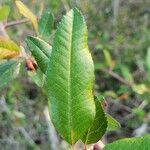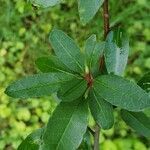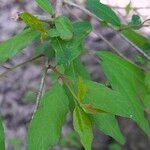Trees, sometimes shrubs, 10–50(–100) dm. Stems 5–25 cm diam.; bark reddish brown to gray, longitudinally fissured with platelike scales; young branches reddish brown, sparsely puberulent, becoming gray or grayish brown, glabrescent; flowering shoots developing as short spurs or spiny thorns, (5–)10–40(–60) mm. Buds reddish brown, ovoid, 1.6 mm, scale margins tomentose. Leaves conduplicate in bud; heteromorphic; stipules deciduous, linear-lanceolate, 2–4(–5) mm, apex acuminate; vigorous shoot leaves: petiole (10–)15–25 mm, villous, sometimes tomentose; blade elliptic, oval, or ovate, sometimes triangular-ovate, (3.5–)4–6(–8) × (1.5–)3–4(–5) cm, base cuneate, sometimes rounded, margins sometimes slightly lobed, crenate, crenate-serrate, serrate, or entire, sometimes doubly serrate, apex rounded, broadly acute, sometimes apiculate, abaxial surface glabrous (villous only on veins), adaxial glabrous; flowering shoot leaves: petiole 3–10(–25) mm, villous, sometimes glabrous; blade elliptic or oblong, sometimes ovate, obovate, or lanceolate, (9–)15–50(–65) × (7–)10–20(–30) mm, base cuneate, sometimes rounded, margins unlobed, crenate, crenate-serrate, or entire, apex rounded (with point or acute), abaxial surface glabrous (veins villous), adaxial glabrous. Panicles corymblike; peduncles absent; bracteoles sometimes persistent, filiform, (1–)3–4(–6) mm. Pedicels (10–)20–30(–40) mm, glabrous, sometimes slightly villous. Flowers 20–30 mm diam.; hypanthium glabrous, rarely slightly villous; sepals triangular, (2–)3–4(–5) mm, equal to tube, apex acuminate, abaxial surface glabrous, adaxial hoary-tomentose; petals pink, sometimes fading white, oblong to narrowly obovate, (10–)12–16(–22) mm, claws (2–)3 mm, margins entire, sinuate, or fimbriate, apex rounded; stamens 20, (7–)9–12(–14) mm, anthers pink or rose before dehiscence; styles 5, connate basally, (6–)9–12(–15) mm, usually slightly longer than stamens, tomentose in proximal 1/3. Pomes green or yellow-green, subglobose, 10–20(–30) mm diam., cores not enclosed at apex; sepals persistent, erect; sclereids abundant surrounding core. Seeds dark brown. 2n = 34 (68).
More
A small tree. The trunk is short. The branches are spreading. The crown is open. It grows 9 m high. The bark is grey or brown and cracks into narrow scaly ridges. The leaves are 2.5-7 cm long and 12-19 mm wide. They are narrowly oval and often have a blunt tip. They are wavy along the edge and have teeth. They are dull green above and paler underneath. They turn brown in autumn. The leaf stalk is slender and 12-19 mm long. The flowers are 2.5-4 cm wide with 5 rounded pink petals. The flowers occur in clusters on long stalks. The fruit are 2-2.5 cm wide and yellow-green. They have long stalks and are sour.
Can be grown by cuttings or seedlings. Seeds needs stratification.




